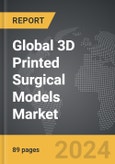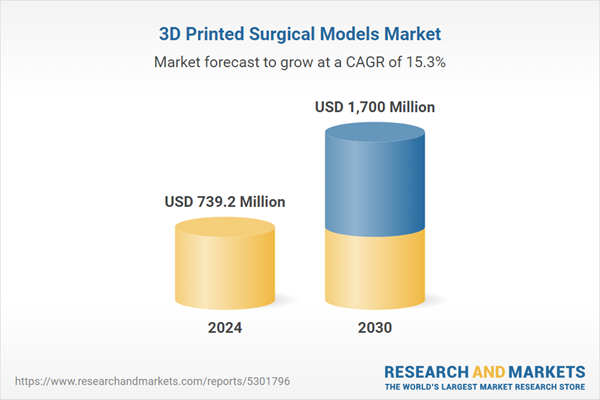Global 3D Printed Surgical Models Market - Key Trends and Drivers Summarized
What Are 3D Printed Surgical Models and How Do They Work?
3D printed surgical models are highly accurate, patient-specific replicas of organs, tissues, or bones, created using advanced 3D printing technology. These models are generated from imaging data, such as CT scans, MRIs, or ultrasounds, which are converted into digital 3D representations through specialized software. The data is then fed into a 3D printer, which produces a physical model using biocompatible materials, polymers, or even multi-material composites that mimic the texture and density of real human tissues. These models provide surgeons with a tangible, accurate representation of a patient's anatomy, allowing them to better understand the specific details of a complex case before surgery. The precision offered by 3D printed surgical models has proven especially useful for planning intricate procedures, such as tumor resections, reconstructive surgeries, and orthopedic interventions. These models allow doctors to rehearse surgeries, test different approaches, and improve their overall preparedness, ultimately leading to better surgical outcomes and fewer complications. As 3D printing technology continues to advance, these models are becoming more detailed, customizable, and integral to personalized surgical care.How Are 3D Printed Surgical Models Changing the Healthcare Landscape?
The use of 3D printed surgical models is having a transformative effect on healthcare, particularly in surgical planning and patient care. These models are revolutionizing how surgeons prepare for complex operations, giving them an opportunity to visualize and handle an exact replica of a patient's anatomy. This hands-on approach is particularly beneficial for high-stakes surgeries, such as those involving congenital heart defects, brain tumors, or craniofacial deformities, where precise knowledge of the patient's unique anatomy can make the difference between a successful outcome and complications. By allowing surgeons to practice on a replica of the patient's organ or tissue, 3D printed models help reduce surgical times, minimize the risk of errors, and improve overall efficiency in the operating room. Additionally, these models are proving valuable in patient education. Physicians can use 3D printed models to show patients and their families exactly what will happen during a procedure, fostering better communication and helping to alleviate anxiety. The models are also used in medical training, providing students and residents with more realistic practice tools compared to traditional cadavers or 2D imaging. In this way, 3D printed surgical models are not only enhancing the precision and confidence of surgeons but are also improving patient satisfaction and training future medical professionals with cutting-edge tools.What Are the Challenges and Limitations of 3D Printed Surgical Models?
Despite the promising advantages of 3D printed surgical models, there are still several challenges and limitations that need to be addressed for broader adoption. One of the main challenges is the cost of producing these models. Although 3D printing technology has become more accessible over time, creating high-quality, patient-specific models still requires expensive imaging data, software, and 3D printing materials. For many healthcare facilities, particularly in resource-limited settings, the cost of integrating 3D printing into surgical planning can be a significant barrier. Additionally, the process of converting imaging data into a printable model can be time-consuming, particularly in urgent or emergency cases where quick decision-making is crucial. Another limitation is the accuracy of the models themselves. While 3D printed surgical models are highly detailed, they may not always capture the full complexity of living tissues, especially when it comes to soft tissues that can shift or change during surgery. Moreover, not all surgical fields have fully integrated 3D printed models into their workflows, with some areas of medicine relying more heavily on traditional imaging methods. There are also regulatory hurdles to consider. In many regions, the approval and validation processes for using 3D printed models in surgical planning are still evolving, which can slow down the adoption of this technology. Overcoming these financial, technical, and regulatory challenges will be key to making 3D printed surgical models a standard part of personalized medicine and surgical care.What Are the Factors Behind the Growth of the 3D Printed Surgical Models Market?
The growth in the 3D printed surgical models market is driven by several key factors, reflecting the increasing demand for personalized medical solutions and advances in 3D printing technology. One of the primary drivers is the rise in complex and high-risk surgeries, where patient-specific models offer surgeons a more detailed understanding of individual anatomies. As surgical procedures become more specialized and targeted, the need for precise pre-surgical planning tools, like 3D printed models, has grown significantly. Another important driver is the increasing use of 3D printed models in medical education and training. These models provide medical students and surgical residents with hands-on practice on lifelike anatomical replicas, improving their skills and readiness for real-life procedures. Additionally, advances in 3D printing technology, such as the ability to print in multiple materials and create models with varying degrees of hardness, have expanded the use cases of 3D printed models, making them more realistic and useful for different types of surgeries, from orthopedics to cardiology. The growing interest in personalized medicine, where treatments and surgeries are tailored to the specific needs of the patient, is also fueling the demand for 3D printed models. These models enable more personalized approaches to surgery, resulting in better outcomes and greater patient satisfaction. Moreover, as healthcare providers increasingly recognize the value of improved surgical accuracy, reduced operation times, and fewer post-operative complications, investments in 3D printing technology are rising. Government support and funding for innovative medical technologies are further accelerating the market's growth, making 3D printed surgical models an essential tool in modern healthcare.Report Scope
The report analyzes the 3D Printed Surgical Models market, presented in terms of market value (US$ Thousand). The analysis covers the key segments and geographic regions outlined below.- Segments: Material (Plastic, Metal, Polymer, Other Materials); Specialty (Orthopedic Surgery, Cardiac Surgery / Interventional Cardiology, Gastroenterology Endoscopy of Esophageal, Neurosurgery, Surgical Oncology, Other Specialties).
- Geographic Regions/Countries:World; United States; Canada; Japan; China; Europe (France; Germany; Italy; United Kingdom; and Rest of Europe); Asia-Pacific; Rest of World.
Key Insights:
- Market Growth: Understand the significant growth trajectory of the PlasticMaterial segment, which is expected to reach US$616.7 Million by 2030 with a CAGR of a 16.1%. The Metal Material segment is also set to grow at 14.7% CAGR over the analysis period.
- Regional Analysis: Gain insights into the U.S. market, valued at $205.9 Million in 2024, and China, forecasted to grow at an impressive 14.3% CAGR to reach $261.3 Million by 2030. Discover growth trends in other key regions, including Japan, Canada, Germany, and the Asia-Pacific.
Why You Should Buy This Report:
- Detailed Market Analysis: Access a thorough analysis of the Global 3D Printed Surgical Models Market, covering all major geographic regions and market segments.
- Competitive Insights: Get an overview of the competitive landscape, including the market presence of major players across different geographies.
- Future Trends and Drivers: Understand the key trends and drivers shaping the future of the Global 3D Printed Surgical Models Market.
- Actionable Insights: Benefit from actionable insights that can help you identify new revenue opportunities and make strategic business decisions.
Key Questions Answered:
- How is the Global 3D Printed Surgical Models Market expected to evolve by 2030?
- What are the main drivers and restraints affecting the market?
- Which market segments will grow the most over the forecast period?
- How will market shares for different regions and segments change by 2030?
- Who are the leading players in the market, and what are their prospects?
Report Features:
- Comprehensive Market Data: Independent analysis of annual sales and market forecasts in US$ Million from 2024 to 2030.
- In-Depth Regional Analysis: Detailed insights into key markets, including the U.S., China, Japan, Canada, Europe, Asia-Pacific, Latin America, Middle East, and Africa.
- Company Profiles: Coverage of players such as 3D LifePrints UK Ltd., 3D Systems, Inc., Axial3D, EnvisionTEC, Formlabs and more.
- Complimentary Updates: Receive free report updates for one year to keep you informed of the latest market developments.
Some of the 34 companies featured in this 3D Printed Surgical Models market report include:
- 3D LifePrints UK Ltd.
- 3D Systems, Inc.
- Axial3D
- EnvisionTEC
- Formlabs
- GPI Prototype
- Lazarus 3D, LLC
- Materialise N.V.
- Onkos Surgical
- Osteo3d
- Stratasys, Ltd.
- WhiteClouds
This edition integrates the latest global trade and economic shifts into comprehensive market analysis. Key updates include:
- Tariff and Trade Impact: Insights into global tariff negotiations across 180+ countries, with analysis of supply chain turbulence, sourcing disruptions, and geographic realignment. Special focus on 2025 as a pivotal year for trade tensions, including updated perspectives on the Trump-era tariffs.
- Adjusted Forecasts and Analytics: Revised global and regional market forecasts through 2030, incorporating tariff effects, economic uncertainty, and structural changes in globalization. Includes historical analysis from 2015 to 2023.
- Strategic Market Dynamics: Evaluation of revised market prospects, regional outlooks, and key economic indicators such as population and urbanization trends.
- Innovation & Technology Trends: Latest developments in product and process innovation, emerging technologies, and key industry drivers shaping the competitive landscape.
- Competitive Intelligence: Updated global market share estimates for 2025, competitive positioning of major players (Strong/Active/Niche/Trivial), and refined focus on leading global brands and core players.
- Expert Insight & Commentary: Strategic analysis from economists, trade experts, and domain specialists to contextualize market shifts and identify emerging opportunities.
Table of Contents
Companies Mentioned (Partial List)
A selection of companies mentioned in this report includes, but is not limited to:
- 3D LifePrints UK Ltd.
- 3D Systems, Inc.
- Axial3D
- EnvisionTEC
- Formlabs
- GPI Prototype
- Lazarus 3D, LLC
- Materialise N.V.
- Onkos Surgical
- Osteo3d
- Stratasys, Ltd.
- WhiteClouds
Table Information
| Report Attribute | Details |
|---|---|
| No. of Pages | 142 |
| Published | December 2025 |
| Forecast Period | 2024 - 2030 |
| Estimated Market Value ( USD | $ 739.2 Million |
| Forecasted Market Value ( USD | $ 1700 Million |
| Compound Annual Growth Rate | 15.3% |
| Regions Covered | Global |








